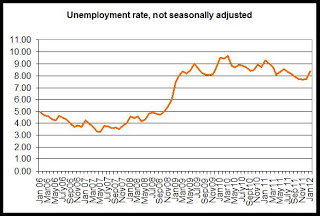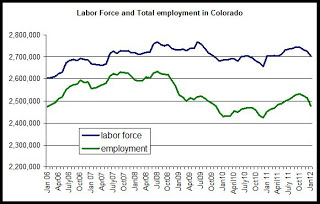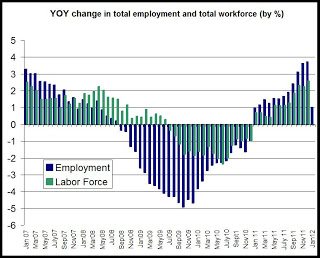In month-to-month comparisons, the unemployment rate increased from 7.7 percent during December to 8.4 percent during January as 37,000 jobs were lost. Seasonally, employment tends to fall from December to January.

From January 2011 to January 2012, total employment rose 1.0 percent, while the labor force shrank 0.02 percent, or was essentially flat. The total labor force in January included 2.70 million workers.
As can be seen in the second graph, total employment and total workforce size have decreased slightly, month-over-month, and have fallen for the past three months. Year over year, employment rose and the labor force was flat. However, both remain well below July 2008 peaks.

The employment total is now 155,000 jobs below the peak levels experienced during July 2008 when there were 2.63 million employed workers. Compared to the labor force peak in July 2008, the labor force is now down by more than 64,100 workers.
In the third graph is shown the year-over-year comparisons, by percent, for total employment. January 2012 was the 13th month in a row showing a positive year-over-year change in total employment. Th3 13 months of increases followed 28 months in a row of negative job growth in year-over-year comparisons.

The graph also shows the year-over-change in the labor force. Total labor force size fell slightly from January 2011 to January 2012, and was the fist time that the labor force has shrunk, year over year, since December 2010. The labor force size had shrunk, year over year, for 18 months in a row from July 2009 to December 2010.
These numbers come from the Household Survey employment data, so the size of the workforce is dependent on the number of people stating that they are actively looking for work if not employed. Discouraged workers who have stopped looking for work are excluded. On the other hand, the Household Survey picks up on small business and start-up employment that may be missed by the Establishment Survey, the other commonly-used measure of employment.
Note: This analysis reflects newly revised data released in January. In most cases, total employment was revised upward for the months of 2011.